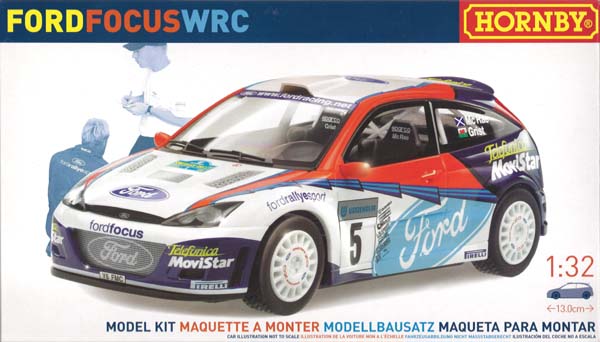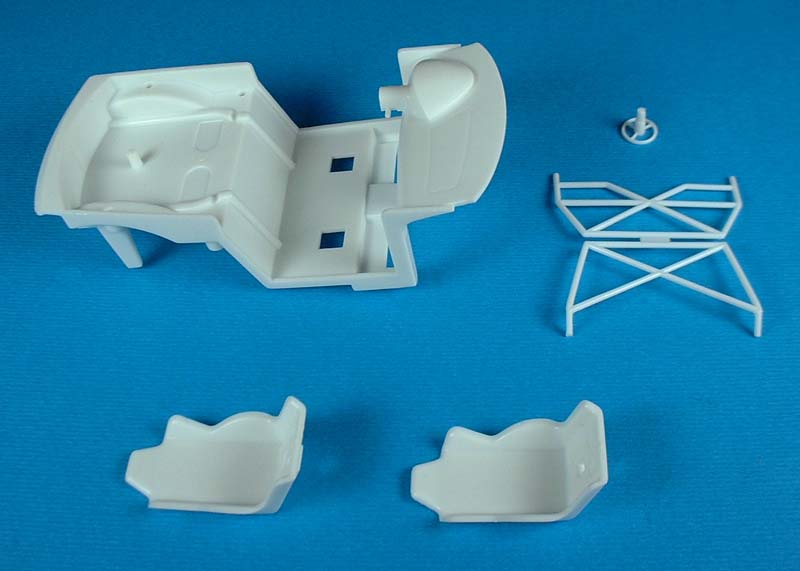
Hornby 1/32 Ford Focus WRC
By Jon Fincher
History
Almost as soon as the first cars were built, people began racing them. While road and off-road racing had existed for decades, it wasn't until 1973 that the FIA organized and sanctioned the World Rally Championship. Based on production cars with turbocharged 2.0 liter engines and four wheel drive, and featuring a paired driver and co-driver (in the role of navigator), the WRC has manufacturers from all around the globe throwing their cars around mixed surface tracks from Europe to Africa.Ford entered the WRC fray at its inception, winning the driver's titles in 1979 and 1981, as well as the manufacturer's title in 1979 with the Ford Escort. Since 1999, however, Ford has competed with version of the Ford Focus, winning their second and third manufacturer's title with it in 2006 and 2007. The Hornby model is not dated, but the marking and style appear to be of an RS WRC 01 or 02 raced in the Uddeholm Swedish Rally sometime around 2003 or 2004.
Initial Thoughts
Hornby's kit comes packaged well - a plastic tray holds three separate bags filled with parts: windscreen, body and interior, and chassis and wheels. The box also contains a single sheet of instructions and decals. Everything fits well and the parts will sustain a pre-build fondle, then return to the box without issue.
The parts provided are sparse (this is a curbside kit with no engine) but well molded and generally clean. None of the parts are on sprues and attachment points are small and tough to find. With the exception of the clear parts (windscreen, headlights, and front running lights) and the tires, everything is molded in white styrene.
Inspection
The lack of interior detail in the kit is evident when the parts are removed from the bag. Aside from two very plain racing seats, a tiny steering wheel, an interior roll cage assembly, and the rally-required spare tire, there is little else to add detail. The interior bucket is, as expected with a racing car, very plain and sparse, and ripe for some additional detail, such as racing harnesses, accelerator, brake, clutch, emergency brake, and fire extinguisher (none are provided in the kit). The seats fit well into the bucket, but have a hole in the middle that allows you to look through to the inside of the chassis.
The chassis and wheel are also very simple, consisting of a simple chassis tray with pins mimicking axles. The underside has a rear differential crudely molded in, as well as an engine skid plate, but is otherwise unremarkable and even confusing - it appears that the muffler and rear diff are connected by a tube structure (in other words, don't display this model on a mirror). The tires are soft rubber with no markings and a simple tread pattern implying a smooth track setup. They stretch over the wheels easily, and the wheels snap on and off the "axles" very well, allowing the model to roll.
Overall parts fit appears to be snug with some notable exceptions. A front clip-like piece fits under the molded-in hood and behind the grill opening. On the other end, windshield wipers extend behind the hood, and the dashboard on interior bucket fits behind it. There will be some fiddling with these parts to make them fit properly, especially since the rear of the interior bucket shows a gap when the front is fit properly. This is similar to the interior bucket to body fit problem of Lindberg's 1953 Ford Victoria. Chassis to body fit is cleverly done, although rear wheel clearance in the wells will need adjustment.
The decals are well protected by cellophane, but that's probably the best thing to be said about them on first glance. The carrier film is thick enough to catch a fingernail, and extends well beyond the color in most cases. There are a number of white and yellow decals which are almost impossible to see on the white paper - you have to look for the sheen of the carrier to know they're there at all.
The instruction sheet is very sparse on details, spending more space on warnings in ten languages and parts inventory than on assembly instructions. Thanks in part to the small parts count and sparse detail, the instructions are readable by experienced modelers. However, Hornby has completely omitted critical items from their instruction sheet, like historical and background information, painting guidance, and even decal placement instructions.
And this leads to the biggest problem with this model: the decals. Decals are provided for a series of blue wedge markings, which lead from the rear wheel well along the side of the car to the front headlight. Another set of wedge markings extends on the roof and the hood, enclosing red and dark blue colors between them. The thickness of the decals may lead to problems applying them over a curved car body with proper alignment and without wrinkles. However, even if they lay down well, the lack of painting instructions is still very problematic. Picking the correct color to match colors on the decals, and then deciding where to actually put it on the model so the decals line up properly, becomes a real issue. Lastly, some of the hard-to-find white and yellow decals need to be placed on top of the dark blue color on the rear of the car. I have not seen any white decals which, when applied over a dark color, actually still appear white, although the thickness of these decals may actually help here.
Conclusion
What appears to be a well-made model at the outset - individually bagged parts, no sprues, crisp molding - begins to fall apart as you dig deeper. The challenges start simply enough - add some interior details, finding proper references, research the historical information, correct some fit issues. But when the time comes to paint the body, the real problems are exposed. What colors do I use? Where do I put them? Will these decals set properly? Will these white decals cover properly? If you absolutely, positively, have to have a 1/32 model of a Ford Focus RS WRC 02 for your collection, these problems are not insurmountable, but they will be challenging. Otherwise, I'd stick with the 1/24 scale Tamiya kit.








